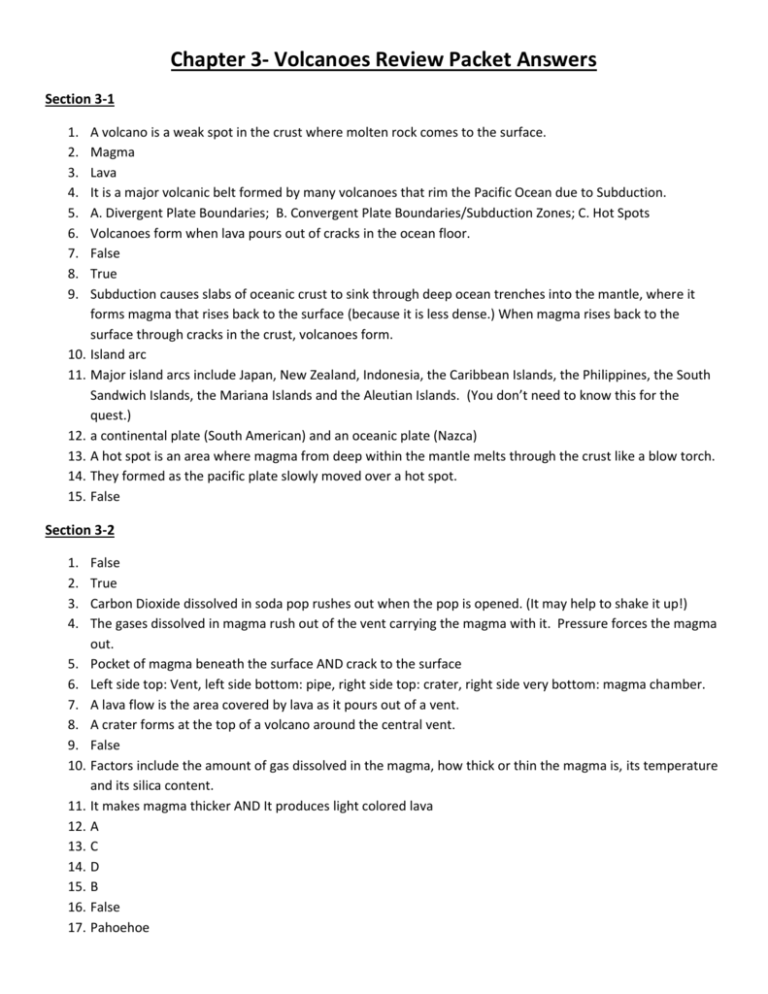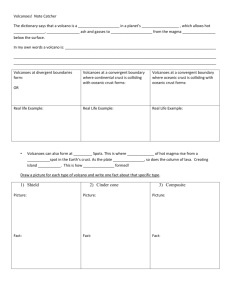Volcanoes Review Packet Answers - High School Geology
advertisement

Chapter 3- Volcanoes Review Packet Answers Section 3-1 1. 2. 3. 4. 5. 6. 7. 8. 9. A volcano is a weak spot in the crust where molten rock comes to the surface. Magma Lava It is a major volcanic belt formed by many volcanoes that rim the Pacific Ocean due to Subduction. A. Divergent Plate Boundaries; B. Convergent Plate Boundaries/Subduction Zones; C. Hot Spots Volcanoes form when lava pours out of cracks in the ocean floor. False True Subduction causes slabs of oceanic crust to sink through deep ocean trenches into the mantle, where it forms magma that rises back to the surface (because it is less dense.) When magma rises back to the surface through cracks in the crust, volcanoes form. 10. Island arc 11. Major island arcs include Japan, New Zealand, Indonesia, the Caribbean Islands, the Philippines, the South Sandwich Islands, the Mariana Islands and the Aleutian Islands. (You don’t need to know this for the quest.) 12. a continental plate (South American) and an oceanic plate (Nazca) 13. A hot spot is an area where magma from deep within the mantle melts through the crust like a blow torch. 14. They formed as the pacific plate slowly moved over a hot spot. 15. False Section 3-2 1. 2. 3. 4. False True Carbon Dioxide dissolved in soda pop rushes out when the pop is opened. (It may help to shake it up!) The gases dissolved in magma rush out of the vent carrying the magma with it. Pressure forces the magma out. 5. Pocket of magma beneath the surface AND crack to the surface 6. Left side top: Vent, left side bottom: pipe, right side top: crater, right side very bottom: magma chamber. 7. A lava flow is the area covered by lava as it pours out of a vent. 8. A crater forms at the top of a volcano around the central vent. 9. False 10. Factors include the amount of gas dissolved in the magma, how thick or thin the magma is, its temperature and its silica content. 11. It makes magma thicker AND It produces light colored lava 12. A 13. C 14. D 15. B 16. False 17. Pahoehoe 18. aa 19. C 20. A 21. B 22. A pyroclastic flow is an explosive eruption of ash, cinders, bombs and gasses. 23. True 24. False 25. Extinct, Active, Dormant 26. False 27. True 28. Hot spring 29. Geyser 30. Stream from deep underground spins the wheel in a turbine and the moving wheel turns a generator that produces electricity. 31. Geologists cannot predict what type of eruption a volcano will produce. 32. They might be unaware of the danger because the time between volcanic eruptions may span hundreds of years. 33. False 34. Volcanoes can start fires, bury towns, damage crops, clog car engines, collapse roofs, stall airplane engines and create landslides, avalanches and mudslides. Section 3-3 1. A- shield volcanoes, B- cinder cone volcanoes, C- composite volcanoes, D- lava plateaus 2. They form from many thin layers of lava. AND… They result from quiet eruptions. 3. False 4. Three examples are Mt. Fuji, Mt. St. Helens and Mt. Hood. (You don’t need to know this for the quest.) 5. True 6. E 7. C 8. B 9. A 10. D 11. Potassium and phosphorus (You don’t need to know this for the quest.) 12. A- volcanic neck, B- dikes, C- sills, D- batholiths, E- done mountains 13. Dike- forms across layers, Sill- forms between layers, Both- forms from magma 14. Batholith 15. An example is the batholith that forms the Sierra Nevada Mountains. (You don’t need to know this for the quest.) 16. True.





